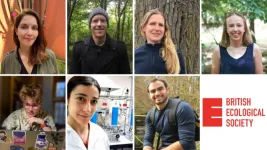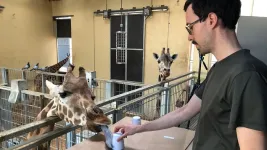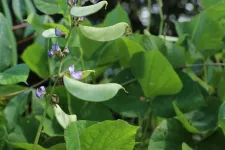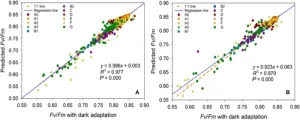(Press-News.org) Artificial photosynthesis for environmentally friendly food production
TUM researchers produce important amino acid from greenhouse gas CO2
Growing demand for food in the world
Biotechnological process via methanol as intermediate product
Less ground required than for plant cultivation
Ensuring the supply of food to the constantly growing world population and protecting the environment at the same time are often conflicting objectives. Now researchers at the Technical University of Munich (TUM) have successfully developed a method for the synthetic manufacture of nutritional protein using a type of artificial photosynthesis. The animal feed industry is the primary driver of high demand for large volumes of nutritional protein, which is also suitable for use in meat substitute products.
A group led by Prof. Volker Sieber at the TUM Campus Straubing for Biotechnology and Sustainability (TUMCS) has succeeded in producing the amino acid L-alanine, an essential building block in proteins, from the environmentally harmful gas CO2. Their indirect biotechnological process involves methanol as an intermediate. Until now, protein for animal feed has been typically produced in the southern hemisphere with large-scale agricultural space requirements and negative consequences for biodiversity.
The CO2, which is removed from the atmosphere, is first turned into methanol using green electricity and hydrogen. The new method converts this intermediate into L-alanine in a multi-stage process using synthetic enzymes; the method is extremely effective and generates very high yields. L-alanine is one of the most important components of protein, which is essential to the nutrition of both humans and animals.
Prof. Sieber, of the TUM Professorship for Chemistry of Biogenic Resources, explains: "Compared to growing plants, this method requires far less space to create the same amount of L-alanine, when the energy used comes from solar or wind power sources. The more efficient use of space means a kind of artificial photosynthesis can be used to produce the same amount of foodstuffs on significantly fewer acres. This paves the way for a smaller ecological footprint in agriculture."
Bioeconomy and hydrogen economy in combination
The manufacture of L-alanine is only the first step for the scientists. "We also want to produce other amino acids from CO2 using renewable energy and to further increase efficiency in the realization process," says co-author Vivian Willers, who developed the process as a doctoral candidate at the TUM Campus Straubing. The researchers add that the project is a good example of how bioeconomy and hydrogen economy in combination can make it possible to achieve more sustainability.
Publication:
The article "Cell-free enzymatic L-alanine synthesis from green methanol" recently appeared in the journal Chem Catalysis from Cell Press.
Vivian Pascal Willers, Manuel Döring, Barbara Beer, Volker Sieber. Cell-free enzymatic L-alanine synthesis from green methanol. Chem Catalysis, Volume 3, Issue 3, 2023, 100502.
https://doi.org/10.1016/j.checat.2022.100502
Further Information:
Chair of Chemistry of Biogenic Resources https://cbr.cs.tum.de/?lang=en
TUM School of Life Sciences https://www.ls.tum.de/en/ls/home/
Background on photosynthesis https://www.150.tum.de/en/anniversary-story/photosynthesis/
Agricultural Sciences https://www.ls.tum.de/en/ls/studies/courses-and-programs/agricultural-and-horticultural-sciences-bsc/
Study programs at TUM School of Life Sciences https://www.ls.tum.de/en/ls/studies/application/
Editorial service:
Image Download: http://go.tum.de/058005
Scientific contact:
Prof. Dr. Volker Sieber
Technical University of Munich (TUM)
TUM Campus Straubing for Biotechnology and Sustainability (TUMCS)
Professorship for Chemistry of Biogenic Resources
Tel.: +49 (0) 9421 187-300
sieber@tum.de
Media contact at TUM Corporate Communications Center:
Ulrich Meyer
Press Spokesperson
Tel. +49 89 289 22779
presse@tum.de
www.tum.de
END
Today the British Ecological Society (BES) has announced the winners of its journal prizes for research published in 2022. The prizes are awarded for the best paper by an early career researcher in seven of the BES journals: Journal of Applied Ecology, Ecological Solutions and Evidence, Functional Ecology, People and Nature, Methods in Ecology and Evolution, Journal of Ecology and Journal of Animal Ecology.
The winning papers are selected by the Senior Editors of the journals and the awards will be presented to the winners at the BES Annual Meeting in Belfast at the end of the year.
The winners receive a prize of £250, membership of the BES, a year’s subscription to ...
Safer cancer drugs are now one step closer after a new study led by UCL (University College London) researchers found the likely reason that some treatments damage the heart.
Modern drugs can be very effective at treating cancer and have led to greatly improved survival rates. However, some cancer treatments can cause damage to the heart, or cardiotoxicity. This damage can present in a range of ways, from a slight change in the heart’s pumping ability to debilitating heart failure. But the ways in which these drugs cause damage ...
Innovating, i.e. the ability to find solutions to new problems or innovative solutions to known problems, it provides crucial benefits for the adaptation and the survival of human beings as well as for animals. What are the characteristics that make specific species or animals to be innovative? A study by the University of Barcelona has analysed this cognitive skill in ungulates, a group of mammals such as dromedaries, horses and goats, characterized by walking on the tip of their toes or hooves. The results show that those individuals that are less integrated ...
NAIROBI, Kenya, 20 April 2023_An international team of researchers, led by Africans, has fully sequenced the genome of a climate resilient bean that could bolster food security in drought-prone regions.
The sequencing of the hyacinth bean or ‘lablab bean’ [Lablab purpureus] paves the way for wider cultivation of the crop, bringing nutritional and economic benefits, as well as much needed diversity to the global food system.
The plant is native to Africa and is cultivated throughout the tropics producing highly nutritious beans, which are used for food ...
Large-scale circulation anomalies are a key factor in the transportation of water vapor and changes in climate. For tropical and subtropical regions, an atmospheric circulation field not only determines the characteristics of the weather situation but also influences the atmospheric circulation in the middle and high latitudes, as well as the global climate, through the transport of energy and angular momentum. At the same time, whilst lightning can serve as a global tropical “thermometer” and an indicator of water vapor in the upper troposphere, the driving role of the circulation situation for it needs to be further analyzed.
In a paper recently ...
During photosynthesis, the green pigment chlorophyll in algae and plants absorbs most of the energy from incoming light. Chlorophyll gets excited and transfers this energy to the energy-harvesting protein complexes photosystem I (PSI) and II (PSII). However, some of this energy dissipates as heat or chlorophyll a fluorescence (ChlF).
Changes in the environment or plant physiology that affect PSII also alter ChlF, which can therefore be used as a fast, sensitive, and non-destructive indicator of PSII status. Indeed, ChlF is a powerful tool for assessing multiple aspects of photosynthesis. Though ChlF measurements ...
FOR IMMEDIATE RELEASE
What: Pediatric Academic Societies (PAS) 2023 Meeting
When: April 27 to May 1
Where: Walter E. Washington Convention Center (801 Mt Vernon Pl NW, Washington, DC 20001)
Johns Hopkins Children’s Center researchers will present on numerous topics during the PAS 2023 meeting, including:
System-Level Approach to Improve First COVID-19 Vaccine Dose Uptake in a Primary Care Setting: The Value of Health Educators
Monday, May 1, 1 to 2:30 p.m. Eastern time
Convention Center: 204 C
Oral Abstract
COVID-19 vaccination rates among youth ...
To gain a clearer understanding of the differences between childhood cancer patients when it comes to the impact of radiation therapy on cognition, scientists at St. Jude Children’s Research Hospital studied the effect of their environment. Their work showed that children with supportive environments fared better than children living in neighborhoods with economic hardship. Those in areas with greater economic hardship had worse baseline and long-term cognitive outcomes. The results imply that policies and resources providing support at a neighborhood level ...
COLUMBUS, Ohio – Researchers at The Ohio State University have developed a framework for quantifying how well countries around the world are doing at providing adequate food, energy and water to their citizens without exceeding nature’s capacity to meet those needs.
They found that only 6% of 178 countries provide for all their citizens in an ecologically sustainable way in both carbon sequestration and water consumption.
The study found that while 67% of nations operate safely and sustainably in regard to water use, only 9% do in regard to carbon sequestration, ...
The International Vaccine Institute, an international organization with a mission to discover, develop, and deliver safe, effective, and affordable vaccines for global health, began clinical development of DuoChol, a new low-cost oral cholera vaccine (OCV) in capsule form. With funding support from the Wellcome Trust and the Swedish government, IVI is preparing to conduct a Phase I clinical trial of the vaccine in Sweden.
Scientists at the University of Gothenburg developed DuoChol, a dry formulation inactivated bacterial whole cell/cholera toxin B subunit OCV with a similar composition as the world’s first WHO-prequalified OCV, DUKORAL®. ...





